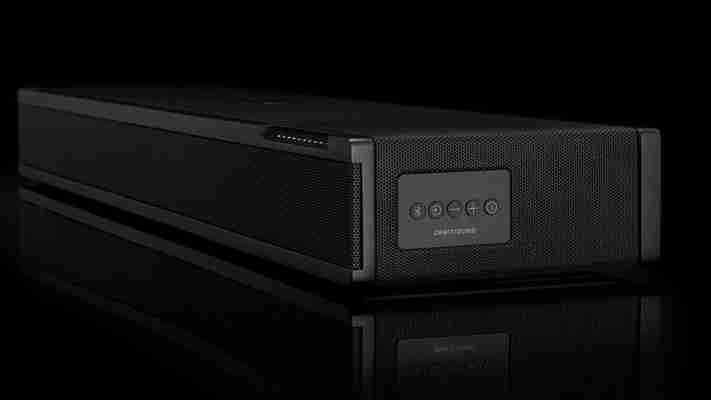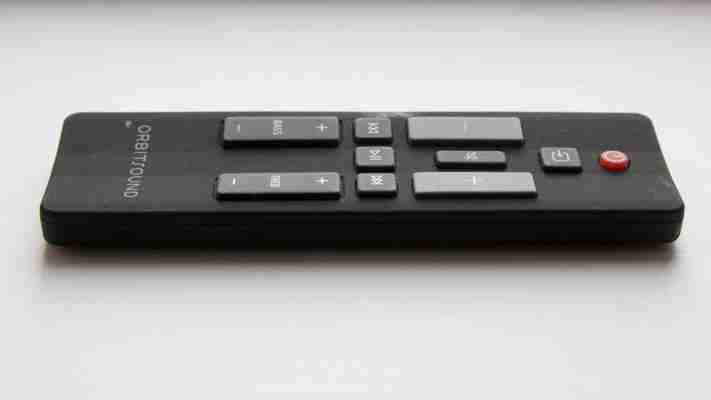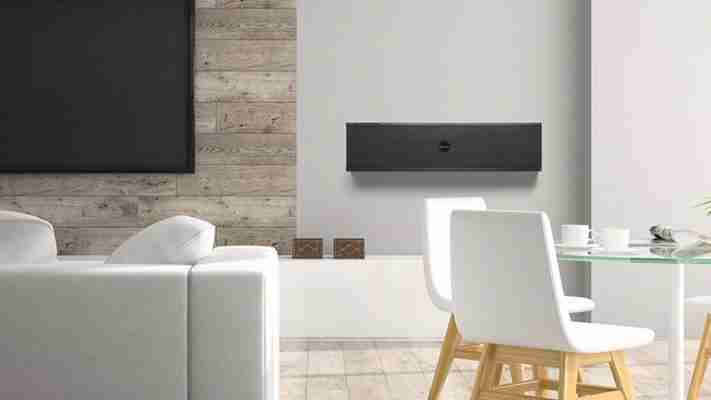TV speakers usually assume one of two form factors: soundbar or soundbase. The Orbitsound One P70 is unusual in that sits in between. It’s not quite slim or wide enough to be deemed a proper soundbar, and it isn’t deep enough to form a platform to plonk your TV on.
Its primary function is the same, though, whatever you want to call it. It’s designed to sit in front of your TV, above or below it and make it sound better. Orbitsound also thinks the One P70 is good enough to use as your main Hi-Fi audio system.
Read next: The 12 best soundbars and soundbases of 2017
Orbitsound One P70 review: Tl;dr
There’s nothing particularly complicated about the Orbitsound One P70. It’s essentially a speaker designed to enhance your TV’s sound quality with added Bluetooth. It has limited connectivity, with no multiroom or Wi-Fi.
However, it comes with built-in “subwoofer”, so setup is easy, it’s equipped with the company’s proprietary 360-degree airSOUND audio tech and it sounds excellent.
Orbitsound One P70 review: Price and competition
That’s all you really need to know about the Orbitsound One P70. What you also need to know is that it’s quite pricey for the features on offer. Maybe not the sound, but I’ll go into that separately.
Basically, there’s huge competition in the TV speaker/soundbar market around this price. Standout products I’ve reviewed recently include the Cambridge Audio TV2, which costs £100 less at £199 from Richer Sounds and the Q Acoustics M3 soundbar at £299.
If you have a quick read of our Best soundbars of 2017 piece, though, you’ll see a number of rival products at £369 and above that offer far more in terms of features.

Orbitsound One P70 review: Design and features
That’s principally because, as hinted at above, the Orbitsound One P70 is somewhat limited when it comes to connectivity. Sitting at the back in a small cavity you’ll spot a 3.5mm input jack, an optical S/PDIF input and nothing else.
There’s no HDMI input, which you might expect from an AV sound system, nor any extra inputs for legacy Hi-Fi equipment.
The Orbitsound does have Bluetooth connectivity, but it lacks Wi-Fi connectivity, so there’s no multiroom capability, Spotify Connect, Google Cast or Apple AirPlay support. In fact, the best way to pipe all your music and sound through the One P70 is to do so via your TV. But that assumes you have little else to connect.
That’s clearly disappointing, but the P70 does look nice and build quality is superb. The chassis is constructed with an engineered wood frame, a wraparound metal grille, and a series of indicator LEDs carved into the front right edge of the case.
There’s also a control panel hidden away on the right-hand edge and a simple to use, but nicely designed infrared remote control that covers all the essential functions. You don’t have to use the remote, though, if you don’t want to because the P70 has a remote learning facility that allows it to operate with your TV remote instead.

The One P70 is deeper than your average soundbar and also quite tall so you’ll need to check the measurements on your TV first. It’s not tall enough to encroach on the screen in most cases but in my case, it obscured the infrared receiver on the TV enough that I had to reach up and point my TV remote down to get it to work.
You don’t have to place it in front of your TV, though. The Orbitsound One P70 can also be wall mounted, either above or below your TV with the brackets provided in the box. A quick button combination press to change the profile of the sound to match the change in orientation of the speaker and you’re ready to go.
Another unusual but welcome feature is “optical boost”, which applies a gain of 7.5dB to the optical input for devices that have a lower than normal output level.
Orbitsound One P70 review: Sound quality
No two ways about it, the Orbitsound One P70 sounds great. Four 2in drivers – two front-facing and two sideways firing lend the audio a pleasingly broad soundstage and the integrated 5.25in subwoofer pounds out the low notes with surprising authority and grip. This is a speaker that’s just as at home with music as it is with TV and movie soundtracks.
Pipe Trentemoeller’s Moan through it and the regular bass pulse kicks out with an enjoyable firmness. Yet there’s plenty of power scale to deal with the explosions and deep rumbles typical of modern action movies.
I’ve been living with the Orbitsound One P70 for a number of weeks now and have, in general, found its performance just as good as that of the Cambridge Audio V2 and Q Acoustics M3, and better than the Yamaha YAS-but with a little extra width on the sound from those side-firing airSOUND speakers.

What it isn’t is the crispest, sharpest-sounding speaker in the world. Vocals and spoken voices were a little too recessed for my liking and though the delivery is very smooth, overall the P70 doesn’t quite pick out the details with as much clarity as I’d like.
The latter isn’t too much of a problem. That’s just me being picky, but the warmth and smoothness of the sound means that at low volume dialogue was a little more difficult to pick out over background sound effects than it should have been.
Orbitsound One P70 review: Verdict
Despite these minor flaws, the One P70 is a competent speaker. It looks good in an understated, minimalist kind of way, it creates an impressively broad sound stage, and it kicks out the bass in a manner that’s really surprising for a unit of its size.
It’s biggest problem is that it isn’t all that fully featured. There’s no Wi-Fi here, and no HDMI connectivity, both essential features in a modern TV living room speaker. If you don’t want more than one speaker in your lounge, this is where the Orbitsound One P70 falls short.
Even the Q Acoustics M3 delivers more connectivity than this and although that soundbar doesn’t deliver quite the same spread of sound, it’s just as bassy, if not more so, than the Orbitsound One P70. On the other hand, the Cambridge Audio TV2 soundbase offers audio that’s very nearly as good for £100 less.
That leaves the P70 in a tricky spot. On the one hand, it’s a terrific TV speaker capable of delivering top quality audio, but the competition is a fraction of a step ahead.

Leave a Reply